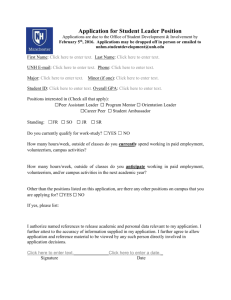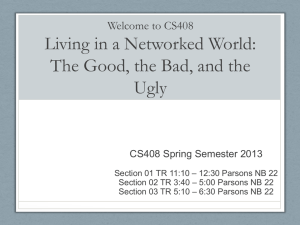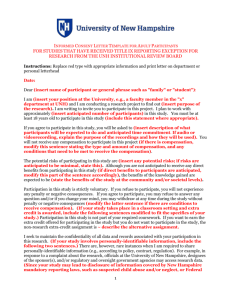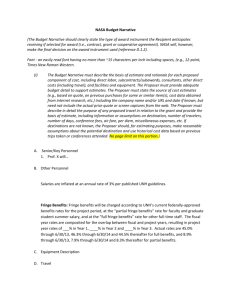Matrix - WordPress.com
advertisement
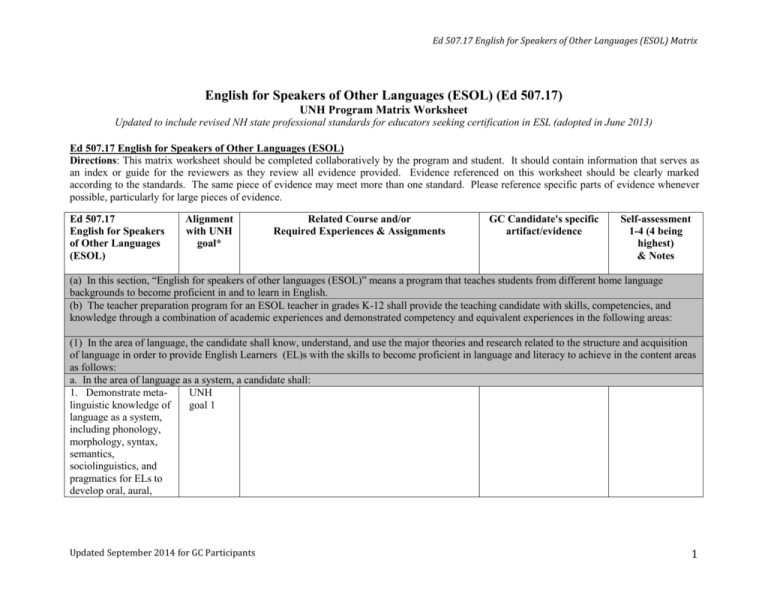
Ed 507.17 English for Speakers of Other Languages (ESOL) Matrix English for Speakers of Other Languages (ESOL) (Ed 507.17) UNH Program Matrix Worksheet Updated to include revised NH state professional standards for educators seeking certification in ESL (adopted in June 2013) Ed 507.17 English for Speakers of Other Languages (ESOL) Directions: This matrix worksheet should be completed collaboratively by the program and student. It should contain information that serves as an index or guide for the reviewers as they review all evidence provided. Evidence referenced on this worksheet should be clearly marked according to the standards. The same piece of evidence may meet more than one standard. Please reference specific parts of evidence whenever possible, particularly for large pieces of evidence. Ed 507.17 English for Speakers of Other Languages (ESOL) Alignment with UNH goal* Related Course and/or Required Experiences & Assignments GC Candidate's specific artifact/evidence Self-assessment 1-4 (4 being highest) & Notes (a) In this section, “English for speakers of other languages (ESOL)” means a program that teaches students from different home language backgrounds to become proficient in and to learn in English. (b) The teacher preparation program for an ESOL teacher in grades K-12 shall provide the teaching candidate with skills, competencies, and knowledge through a combination of academic experiences and demonstrated competency and equivalent experiences in the following areas: (1) In the area of language, the candidate shall know, understand, and use the major theories and research related to the structure and acquisition of language in order to provide English Learners (EL)s with the skills to become proficient in language and literacy to achieve in the content areas as follows: a. In the area of language as a system, a candidate shall: 1. Demonstrate metaUNH linguistic knowledge of goal 1 language as a system, including phonology, morphology, syntax, semantics, sociolinguistics, and pragmatics for ELs to develop oral, aural, Updated September 2014 for GC Participants 1 reading, and writing skills in English; 2. Demonstrate knowledge of historical development of the English language; 3. Relate knowledge of English to languages spoken by students in their communities; and 4. Build on similarities between English and the student’s home language (L1) and to anticipate any difficulties that learners may have with English; UNH goal 1 UNH goals 1, 2 UNH goals 2, 3 1b. In the area of language acquisition and development, a candidate shall: 1. Understand and UNH apply concepts and goals 1, 3 theories of first and second language acquisition to facilitate ELs’ development of social and academic English language; 2 Ed 507.17 English for Speakers of Other Languages (ESOL) Matrix 2. Demonstrate understanding of current and historical theories and research related to the structure and acquisition of language so that ELs can acquire use of language and literacy in the content areas; UNH goals 1, 3 3. Demonstrate language proficiency in oral and written English in social and academic settings for ELs; 4. Understand the role of personal and affective variables in language learning to establish secure, motivating classrooms in which ELs take risks and use language productively; and 5. Understand how to use linguistic scaffolding to facilitate comprehension and production of academic and social English; and 6. Have had the UNH goal 1 UNH goals 1, 2, 3 UNH goal 3 UNH Updated September 2014 for GC Participants 3 experience of studying a second language, which may include American Sign Language, by one of the following: (i) Successfully completing at least two semesters of the study of a second language at the college level; or (ii) Demonstrating evidence of equivalent of 2 semesters of study of a second language at the college level, including, but not limited to, documentation of the acquisition of a second language during foreign residency. goal 1 (2) In the area of culture, the candidate know, understand and use major theories and research related to the nature and role of culture in instruction for the following: a. The major principles, theories, and research related to the nature and role of culture on language learning, school UNH goals 1, 2 4 Ed 507.17 English for Speakers of Other Languages (ESOL) Matrix achievement, and acculturation; b. The nature and role of culture to construct learning environments to support ELs’ cultural identities and academic needs; c. Cultural groups in the community, including the majority group, affect language learning, social adjustment, school achievement and acculturation; d. Use of curriculum and materials to promote an inclusive environment and demonstrates crosscultural awareness and appreciation; and UNH goals 1, 2, 3 UNH goals 2, 3 UNH goals 2, 3 e. Use of resources to UNH maintain up-to-date goals 2, 6 knowledge of cultural conflicts and world events that might have an impact on student’s learning; (3) In the area of instruction, the candidate shall understand and use evidence-based practices and strategies to plan, implement and Updated September 2014 for GC Participants 5 manage standards-based ESOL and content instruction as follows: 3a. For planning for standards-based ESOL content instruction: 1. Plan standards-based ESOL and content instruction to meet learning objectives; and UNH goals 2, 3, 4 2. Plan differentiated UNH instruction based on goals 2, 3, assessment of students’ 4 English and L1 proficiency, learning styles, and prior formal educational experiences and knowledge; and 3b. For implementing and managing instruction: 1. Understand different ESOL program models such as but not limited to push-in, pull-out, and self contained; UNH goals 1, 3, 6 2. Develop students’ listening and speaking skills for a variety of academic and social purposes; 3. Use standards-based instruction that builds on students’ oral English skills to support UNH goals 3, 4 UNH goals 3, 4 6 Ed 507.17 English for Speakers of Other Languages (ESOL) Matrix reading and writing; 4. Utilize standardsUNH goals based reading and 3, 4 writing instruction adapted to ELs; 5. Implement activities UNH goals to integrate listening, 3, 4 speaking, reading, and writing; 6. Implement activities UNH and materials that goal 3 develop authentic uses of language as students learn academic vocabulary and contentarea material; and 7. Use a variety of UNH resources including but goal 3 not limited to, technology, print and realia; (4) In the area of assessment, a candidate shall demonstrate an understanding of various assessment issues as they affect ELs, such as but not limited to accountability, bias, special education testing, language proficiency, and accommodations in formal testing situations as follows: 4a. For educational assessment: 1. The purpose of the assessment as they relate to ELs; 2. Key indicators of good assessment UNH goal 4 UNH goal 4 Updated September 2014 for GC Participants 7 instruments; 3. The advantages and UNH limitations of goals 4, 6 assessments, including accommodations for ELs; and 4. Language UNH goals differences, giftedness, 2, 3, 4 and special education needs; 4b. For language proficiency assessment: 1. Know state eligibility UNH goals and reclassification 4, 6, 7 requirements for ELs; 2. Understand the UNH goals appropriate use of 4, 6 norm-referenced assessments with ELs; and 3. Knowledge of UNH goals standards-based and 4, 6 performance-based assessment tools that measure EL progress; and 4c. Know and use a variety of performance-based assessment tools and techniques to inform instruction for classroom assessment; and Know and use a variety of performance-based assessment tools to inform instruction for UNH goals 3, 4 8 Ed 507.17 English for Speakers of Other Languages (ESOL) Matrix classroom assessment (5) In the area of professionalism, the candidate shall demonstrate knowledge of history, research and educational policy as follows: a. The evolution of the UNH laws and policies goal 6 affecting linguistic minorities in the U.S., including those which govern the educational rights of ELs; b. The importance of collaborating with teachers and staff to provide comprehensive, appropriate educational opportunities for ELs in school; and c. The importance of providing EL families with information regarding school and community resources. UNH goals 6, 7 UNH goals 2, 6 *These goal alignments are meant to be guides. You can make a case for different UNH goal alignment depending on your specific artifact or evidence. Additionally, all areas of the matrix can serve to fulfill UNH goal #5 (Our graduates are thoughtful and reflective practitioners who learn from experience.) Updated September 2014 for GC Participants 9
